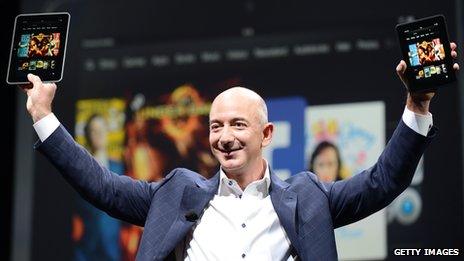Will Amazon's customers swallow a bigger tablet?
- Published
- comments

Amazon founder Jeff Bezos with the larger Kindle Fire HD
Last night the tablet market in the UK got a bit more crowded as Amazon announced that the larger 8.9in (22.6cm) version of its Kindle Fire HD was going on sale here.
Just as users seemed to be showing a preference for smaller tablets, Amazon is giving them a bigger one - so what does that say about where the market is heading?
Until last September it looked as though Apple, the company that created the tablet market, was pretty secure in its dominance in the UK. Sure, there were any number of Android devices, including Google's own impressive Nexus 7, but the 10in (25.4cm) iPad remained the one that most consumers aspired to own.
Then, Amazon finally brought the 7in (17.8cm) Kindle Fire to the UK, nearly a year after its US launch. With a brand name far more recognisable than the other Android contenders it was bound to do well. And the fact that it was being sold at around cost price - as Amazon boss Jeff Bezos told us last year - meant that it was the bargain tablet at Christmas.
While it is hard to get reliable statistics for tablet sales, a survey by YouGov seems to show that the Kindle Fire came from nowhere to challenge for the lead over the festive season. Its survey of people who bought tablets as gifts showed that the Fire was the single top choice, although combining the iPad and the iPad mini gave Apple a bigger share.
Overall, 2012 was the year in which tablets really went mainstream in the UK. According to Ipsos Mori, the year started with 7% of the adult population owning an iPad, with another two percent owning another kind of tablet. A year on the same company says iPad ownership is up to 16%, with 10% owning another tablet.
So the market has more than doubled, and while iPad ownership has soared, others are beginning to make inroads into its market share.
But it was the smaller tablets - the Nexus 7 and the Kindle Fire - which started to change the dynamics of the market, forcing Apple to do something that Steve Jobs had ruled out, make a smaller cheaper iPad.
With rumours that the iPad Mini is starting to cannibalise sales of its big brother, it seems somewhat strange for Amazon now to be bringing out a larger model. So will there be much demand for it here?
At £229, it is almost half the price of the full-size iPad which starts at £399. As in the US, owners will see adverts on the lock screen, unless they pay an extra £10. And the whole experience is built around driving you to Amazon content, with a home screen directing you to books and music you can buy from its store, and video from Lovefilm, the British business it bought in 2011.
The device does not feel as open and flexible as other Android tablets, nor anything like as slick as the iPad and it certainly does not have the range of apps that Apple can offer.
In fact, having spent a few days with the device, I struggle to see where it fits into Amazon's strategy. The original Kindle dominates the e-reader market, the 7in Kindle Fire is becoming the tablet of choice for more budget-conscious consumers. Will many of them pay £70 more for the same package on a bigger screen?
Still, having watched how Samsung crept up on Apple in the smartphone market, then accelerated past with a wider range of devices, maybe Amazon feels it is equipped to do the same. The good news for both firms is that the tablet revolution seems to have much further to run - the bad news for the older PC makers trying to get into this business is that they could be left trailing as Apple and Amazon race off into the distance.